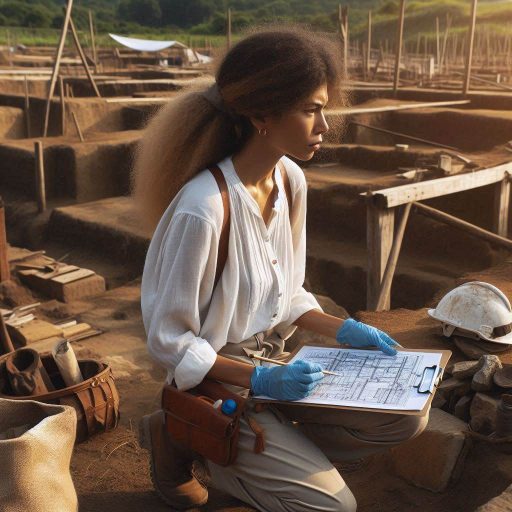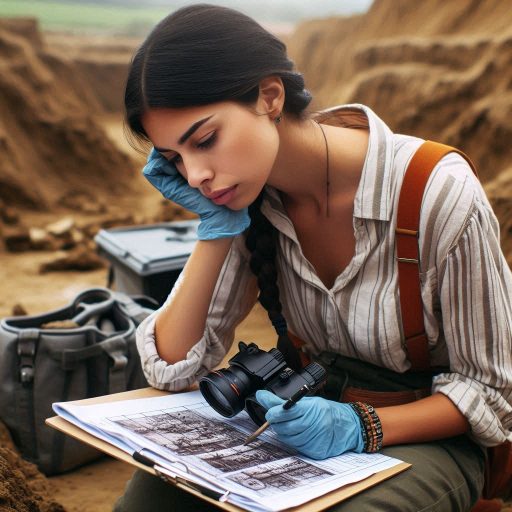Introduction
Archaeology and anthropology are two interconnected disciplines that explore the complexities of human existence.
Archaeology is the study of past human societies through their material remains, such as artifacts, structures, and landscapes.
By excavating and analyzing these physical remnants, archaeologists uncover insights into how people lived, interacted, and adapted to their environments.
On the other hand, anthropology is the broader study of humanity, encompassing cultural, social, biological, and linguistic dimensions.
Anthropologists investigate the behaviors, beliefs, and practices that define different cultures and societies, often employing ethnographic methods to understand contemporary communities.
The relationship between archaeology and anthropology is essential, as each field informs and enriches the other.
Archaeological findings provide a historical context that enhances anthropological theories, while anthropological perspectives can guide the interpretation of archaeological data.
Understanding this relationship is crucial for studying human behavior, cultural evolution, and societal change.
By examining the interplay between material culture and social dynamics, scholars can gain a more comprehensive view of humanity’s past and its implications for the present and future.
Studying this relationship fosters a deeper appreciation of how humans have navigated their environments and shaped their cultures over time.
History of Archaeology and Anthropology
Overview of the Development of Both Fields
Archaeology and anthropology are intertwined disciplines that explore human history and culture.
Archaeology focuses on material remains, while anthropology studies human societies and behaviors.
Both fields have evolved significantly since their inception.
The roots of archaeology trace back to the Renaissance when scholars began to study ancient artifacts.
Initially, archaeology operated more like treasure hunting than a scientific discipline.
In the 19th century, archaeologists like Heinrich Schliemann sparked public interest through excavations at Troy.
Schliemann’s work emphasized the importance of systematic excavation and documentation.
Anthropology emerged as a formal field in the 19th century.
Pioneers such as Edward Burnett Tylor and Franz Boas laid the groundwork for cultural anthropology.
Tylor introduced the concept of culture, defining it as a complex whole that includes knowledge, beliefs, and customs.
Boas emphasized the importance of fieldwork and cultural relativism, arguing against ethnocentric views.
How They Have Evolved Independently
While both fields began to develop independently, they share common interests.
Archaeology has increasingly incorporated anthropological theories and methods.
This integration has enhanced our understanding of past human behaviors.
Conversely, anthropology has benefited from archaeological findings, which provide tangible evidence of cultural practices.
Over time, archaeology adopted more scientific methods, transitioning from treasure hunting to rigorous research.
Techniques such as stratigraphy and radiocarbon dating have transformed the field.
Anthropology has also evolved, embracing diverse approaches, including cultural, social, and biological anthropology.
This diversification allows for a richer understanding of human societies.
Key Figures Who Have Contributed to Both Fields
Key figures have played crucial roles in the development of both fields.
In archaeology, figures like Arthur Evans and Mortimer Wheeler made significant contributions.
Evans is best known for his excavation of the Minoan palace at Knossos.
He introduced the concept of stratigraphy, emphasizing the importance of layers in understanding historical context.
Wheeler, on the other hand, developed the ‘Wheeler-Kenyon Method.
‘ This technique improved excavation practices and encouraged a more scientific approach to fieldwork.
Both Evans and Wheeler set high standards for archaeological methodology that still influence the field today.
In anthropology, notable figures like Margaret Mead and Claude L‘vi-Strauss shaped the discipline.
Mead’s studies in Samoa challenged Western assumptions about gender roles and sexuality.
She used ethnographic research to demonstrate cultural influences on behavior.
L‘vi-Strauss introduced structuralism, analyzing the underlying structures of human thought and culture.
His work highlighted the importance of mythology and symbolism in understanding societies.
Both Mead and L‘vi-Strauss expanded the scope of anthropology and influenced its direction.
Today, archaeology and anthropology continue to evolve.
They increasingly emphasize interdisciplinary collaboration, incorporating techniques from genetics, environmental science, and history.
This integration allows researchers to construct more comprehensive narratives of human experience.
Understanding the history and evolution of archaeology and anthropology reveals their dynamic relationship.
As these fields progress, they deepen our knowledge of humanity and its diverse cultures.
This collaboration will likely enhance our understanding of human societies for generations to come.
Read: Women in Botany: Celebrating Pioneers and Leaders
Methodologies in Archaeology and Anthropology
Contrasts and Similarities in Research Methods
Archaeology and anthropology employ distinct yet complementary methodologies.
Archaeology primarily relies on the excavation of material remains, such as artifacts, structures, and ecofacts.
Researchers meticulously document layers of soil, using stratigraphy to establish chronological sequences.
Excavation involves careful planning, mapping, and recording to ensure accurate analysis of historical contexts.
In contrast, anthropology emphasizes qualitative research methods, including participant observation, interviews, and ethnographic studies.
Anthropologists immerse themselves in the cultures they study, gaining insights into social dynamics and human behavior.
This approach fosters a deep understanding of cultural practices and beliefs from the perspective of community members.
Despite these differences, both fields share common research goals.
Both seek to understand human behavior and culture through systematic observation and analysis.
They often use similar techniques, such as comparative analysis and contextualization, to interpret findings.
This overlap allows for fruitful collaboration and cross-disciplinary insights.
Importance of Interdisciplinary Collaboration
Interdisciplinary collaboration is essential for advancing knowledge in both fields.
By working together, archaeologists and anthropologists can combine their expertise to build comprehensive narratives of human history.
Archaeologists provide material evidence that complements anthropological theories, while anthropologists offer cultural context to archaeological findings.
Collaborative projects often lead to innovative research methodologies.
For example, combining archaeological excavation data with anthropological interviews can yield a richer understanding of past societies.
Such integration enhances the interpretation of artifacts, allowing researchers to explore cultural significance and meaning.
How Methods in One Field Can Benefit the Other
Methods in one field can significantly benefit the other, fostering deeper insights into human history.
For instance, archaeological data can inform anthropological studies by providing concrete evidence of cultural practices.
Artifacts recovered from sites can reveal information about daily life, trade networks, and social structures.
Conversely, anthropological methods can enhance archaeological research.
Ethnographic studies can guide archaeologists in interpreting material remains within cultural contexts.
Understanding contemporary cultural practices can shed light on past behaviors and beliefs, providing a more nuanced perspective on historical events.
Furthermore, advancements in technology, such as remote sensing and GIS, have transformed both fields.
These tools allow researchers to analyze large datasets, map archaeological sites, and visualize cultural landscapes.
Integrating these technologies enhances the efficiency and accuracy of research in both archaeology and anthropology.
In essence, the methodologies of archaeology and anthropology, while distinct, offer valuable opportunities for collaboration.
By leveraging the strengths of each discipline, researchers can deepen their understanding of human societies and their complex histories.
The ongoing dialogue between these fields will continue to illuminate the intricacies of human culture, fostering a richer appreciation for our shared past.
Read: How Climate Change Is Impacting Plant Research
Theoretical Frameworks in Archaeology and Anthropology
Overview of Theories in Each Field
Archaeology and anthropology are grounded in various theoretical frameworks that shape research and interpretation.
In archaeology, several key theories guide understanding of past societies.
Processual archaeology emphasizes scientific methods and the analysis of cultural processes through empirical data.
This approach seeks to understand how societies adapt to their environments and change over time.
Post-processual archaeology challenges the assumptions of processualism, focusing instead on the subjective interpretations of culture.
It emphasizes individual agency, symbolic meanings, and the role of social context in shaping human behavior.
This approach acknowledges that archaeological interpretations are influenced by the perspectives of researchers.
In anthropology, theories also vary significantly.
Cultural relativism stresses understanding cultures on their own terms, avoiding ethnocentric judgments.
This approach emphasizes the importance of context and cultural specificity.
Structuralism, championed by Claude L‘vi-Strauss, analyzes the underlying structures of human thought and cultural practices, revealing universal patterns across diverse societies.
Another influential framework in anthropology is symbolic interactionism, which examines how individuals create meaning through social interactions.
This theory emphasizes the dynamic nature of culture and the importance of language in shaping human experiences.
How Theories from One Field Can Be Applied in the Other
Theories from one field can be effectively applied in the other, enhancing understanding of human behavior and culture.
For instance, processual archaeology’s emphasis on scientific rigor and empirical data can inform anthropological studies.
Archaeologists‘ focus on environmental adaptations can provide valuable insights into cultural practices and social organization.
Conversely, post-processual archaeology’s focus on interpretation and meaning can enrich archaeological analysis.
By incorporating anthropological theories, archaeologists can gain a deeper understanding of the cultural significance of artifacts and structures.
This synergy allows for a more nuanced interpretation of material remains, considering both empirical evidence and cultural context.
Examples of Successful Interdisciplinary Research Projects
Several interdisciplinary research projects exemplify the successful application of theories across archaeology and anthropology.
One notable example is the study of the ancient Maya civilization.
Researchers have combined archaeological evidence, such as site excavations and artifact analysis, with ethnographic studies of contemporary Maya communities.
This collaboration provides insights into the continuity and change in cultural practices over time.
Another example is the investigation of the social dynamics of prehistoric hunter-gatherer societies.
Archaeologists have utilized anthropological theories to analyze settlement patterns and resource distribution.
By integrating ethnographic insights, researchers can better understand the social structures and relationships that influenced these communities.
Additionally, the integration of genetics into both fields has yielded significant discoveries.
Projects examining the migration patterns of ancient populations utilize archaeological findings alongside genetic data.
This interdisciplinary approach has revealed insights into the movement and interaction of diverse cultures, enhancing our understanding of human history.
Theoretical frameworks in archaeology and anthropology provide valuable tools for understanding human societies.
By applying theories from one field in the other, researchers can gain deeper insights into cultural practices and behaviors.
Successful interdisciplinary research projects demonstrate the potential for collaboration between archaeology and anthropology, leading to enriched interpretations of our shared human heritage.
Read: Exploring the Different Branches of Geology

Contributions to Society
How Archaeology and Anthropology Contribute to Our Understanding of Human History
Archaeology and anthropology play crucial roles in expanding our understanding of human history.
Archaeology uncovers material remains, such as tools, structures, and artifacts, revealing insights into past societies.
These discoveries help reconstruct daily life, social structures, and cultural practices, painting a vivid picture of how people lived.
Anthropology complements this by studying contemporary cultures and their evolution.
By examining social norms, beliefs, and practices, anthropologists provide context for historical findings.
Together, these fields create a comprehensive narrative of human development, highlighting the diversity and complexity of cultural expressions throughout time.
Ways in Which They Inform Modern Social Issues
Archaeology and anthropology also inform modern social issues by addressing topics such as identity, migration, and cultural preservation.
As globalization accelerates, understanding cultural diversity becomes increasingly important.
Anthropology provides valuable insights into the dynamics of multicultural societies, helping to foster tolerance and coexistence.
Archaeological studies of past migrations and interactions among cultures offer perspectives on current issues related to immigration and cultural exchange.
By examining historical patterns of movement and adaptation, researchers can contribute to discussions about contemporary migration policies and societal integration.
Furthermore, both fields engage with pressing social issues like climate change and environmental degradation.
Archaeological evidence of how past societies adapted to environmental shifts can inform modern responses to similar challenges.
Anthropology’s focus on local knowledge and practices can guide sustainable approaches to resource management.
Importance of Preserving and Studying Cultural Heritage
Preserving and studying cultural heritage is vital for future generations.
Archaeology uncovers the material remains of past cultures, while anthropology emphasizes the importance of intangible heritage, such as traditions and languages.
Together, they advocate for the preservation of both aspects of cultural heritage.
Cultural heritage fosters a sense of identity and belonging, connecting communities to their histories.
Understanding cultural heritage can help communities navigate modern challenges by drawing on their historical experiences and values.
Additionally, preserving cultural heritage promotes educational opportunities and tourism, generating economic benefits for communities.
By sharing their histories, societies can promote cultural pride and awareness, fostering respect for diversity.
Archaeology and anthropology contribute significantly to our understanding of human history and modern social issues.
Their collaborative efforts shed light on the complexities of cultural heritage, emphasizing the need for preservation and study.
By exploring the past, these fields empower societies to address contemporary challenges while honoring their rich histories.
Read: Top Skills Needed for a Successful Geology Career
Gain More Insights: From Academia to Industry: Data Science Careers
Challenges in the Relationship Between Archaeology and Anthropology
Ethical Considerations in Collaborative Research
The relationship between archaeology and anthropology faces several challenges, particularly regarding ethical considerations.
Collaborative research often involves sensitive cultural materials and living communities.
Ethical dilemmas arise when researchers do not adequately address the rights and voices of the communities they study.
Indigenous groups and local communities often have distinct perspectives on their cultural heritage.
Archaeologists and anthropologists must prioritize these voices in their research.
Ensuring ethical collaboration means involving communities in decision-making processes.
This participation fosters trust and respect, enhancing the research’s relevance and impact.
Researchers must also navigate issues related to the ownership of cultural artifacts.
Questions arise regarding who has the right to excavate, study, and display these materials.
Ethical frameworks must guide these discussions to promote fair and equitable practices in both archaeology and anthropology.
Balancing Scientific and Cultural Perspectives
Another significant challenge lies in balancing scientific and cultural perspectives.
Archaeology often emphasizes scientific methods and empirical data, while anthropology focuses on subjective cultural interpretations.
This divergence can lead to misunderstandings and conflicts in interdisciplinary research.
Striking a balance requires open communication and mutual respect between researchers.
Archaeologists must be willing to consider cultural interpretations of their findings.
Similarly, anthropologists should acknowledge the importance of scientific rigor in archaeological research.
Collaborating researchers can enrich their analyses by blending these perspectives.
Developing interdisciplinary frameworks that value both scientific and cultural approaches is essential.
This integration fosters a holistic understanding of human societies, encouraging researchers to explore how material culture and social practices influence one another.
Transform Your Career Today
Unlock a personalized career strategy that drives real results. Get tailored advice and a roadmap designed just for you.
Start NowFunding and Institutional Barriers to Interdisciplinary Work
Funding and institutional barriers also pose challenges to interdisciplinary work.
Research projects that bridge archaeology and anthropology often struggle to secure financial support.
Granting agencies may prioritize traditional approaches, limiting opportunities for innovative interdisciplinary research.
Additionally, academic institutions can sometimes foster silos between disciplines.
Researchers may face pressure to publish in discipline-specific journals, hindering collaborative efforts.
Overcoming these barriers requires institutional support for interdisciplinary initiatives, encouraging scholars to work together on shared goals.
Establishing funding opportunities specifically for collaborative projects can also promote interdisciplinary research.
By supporting initiatives that combine archaeological and anthropological methods, funding agencies can drive innovation and enhance our understanding of complex cultural issues.
The relationship between archaeology and anthropology faces several challenges that require attention and collaboration.
Ethical considerations, balancing scientific and cultural perspectives, and addressing funding and institutional barriers are critical for advancing interdisciplinary research.
By fostering open dialogue and mutual respect, these fields can work together to enrich our understanding of human history and culture.
Emphasizing the importance of collaborative efforts will ensure that both disciplines continue to contribute valuable insights to society.
Gain More Insights: Biomedical Engineering Internships: Tips for Success
Case Studies
Examples of Successful Collaborations Between Archaeologists and Anthropologists
Several case studies illustrate the fruitful collaborations between archaeologists and anthropologists.
One notable example is the Maya research project in Guatemala, where archaeologists and anthropologists worked together to investigate ancient Maya civilization.
The collaboration involved excavating ancient cities while simultaneously conducting ethnographic studies of modern Maya communities.
This integrative approach provided insights into the continuity of cultural practices and beliefs from ancient to contemporary times.
Another significant case study is the Cahokia Mounds project in Illinois.
Archaeologists excavated the mounds, while anthropologists studied the cultural significance of these structures within local Indigenous communities.
Together, they explored how the mounds functioned as ceremonial and political centers, enhancing our understanding of the social organization and cultural practices of the Mississippian culture.
Additionally, the Kahuku Ranch project in Hawaii serves as an excellent example of interdisciplinary collaboration.
Archaeologists focused on the excavation of historical sites while anthropologists engaged with Native Hawaiian communities.
This collaboration aimed to preserve cultural heritage and incorporate traditional knowledge into archaeological interpretations, ultimately fostering respect for Indigenous perspectives.
How These Collaborations Have Advanced Our Knowledge in Both Fields
These successful collaborations have significantly advanced knowledge in both archaeology and anthropology.
The Maya project allowed researchers to contextualize archaeological findings within contemporary cultural frameworks, enriching interpretations of ancient artifacts and structures.
By understanding how modern Maya people view their heritage, researchers gained insights into the lasting impact of historical events on present-day identities.
In the Cahokia Mounds project, the integration of archaeological and anthropological data revealed the complexity of social hierarchies and cultural practices in Mississippian societies.
This collaboration illuminated the interplay between physical structures and social organization, leading to a more nuanced understanding of ancient American cultures.
The Kahuku Ranch project highlighted the importance of integrating Indigenous knowledge into archaeological research.
This collaboration demonstrated how traditional practices could inform contemporary archaeological methods, resulting in more accurate and culturally sensitive interpretations of historical sites.
Lessons Learned from These Case Studies
Several lessons emerge from these case studies, emphasizing the importance of collaboration between archaeologists and anthropologists.
First, engaging with local communities fosters trust and respect, leading to more meaningful research outcomes.
Collaborative efforts should prioritize the inclusion of community voices in the decision-making process.
Second, interdisciplinary research enhances the depth of analysis.
By combining methodologies and perspectives from both fields, researchers can uncover insights that may remain hidden within a single disciplinary approach.
This synergy encourages innovation and a holistic understanding of complex cultural phenomena.
Finally, establishing ethical frameworks for collaboration is crucial.
Researchers must address issues related to cultural sensitivity, ownership of artifacts, and the rights of communities involved in the research.
Respecting these ethical considerations fosters positive relationships and contributes to the integrity of both disciplines.
Successful collaborations between archaeologists and anthropologists demonstrate the potential for interdisciplinary research to advance our understanding of human history and culture.
By learning from these case studies, researchers can continue to foster meaningful partnerships that enrich both fields and contribute to the preservation of cultural heritage.
Conclusion
The relationship between archaeology and anthropology is crucial for a comprehensive understanding of human history and culture.
Archaeology uncovers material remains, offering insights into past societies, their lifestyles, and their environments.
These artifacts help us piece together the daily lives of people from different eras.
Anthropology complements this by examining cultural, social, and behavioral aspects of human life.
Together, they provide a richer narrative of humanity‘s journey.
Interdisciplinary collaboration is essential for advancing research in both fields.
By integrating archaeological findings with anthropological theories, researchers can develop more nuanced interpretations of human behavior.
This collaborative approach fosters the sharing of methodologies, leading to innovative research techniques.
For instance, anthropologists can apply ethnographic methods to archaeological contexts, enhancing the understanding of cultural practices.
Future research directions should prioritize this interdisciplinary collaboration.
Researchers must advocate for partnerships that encourage innovative approaches to complex questions.
Incorporating perspectives from both fields can reveal patterns and connections that may otherwise remain hidden.
Moreover, addressing global challenges such as climate change and cultural heritage preservation requires collaborative efforts.
By working together, archaeologists and anthropologists can tackle these issues more effectively.
[E-Books for Sale]
The Big Book of 500 High-Paying Jobs in America: Unlock Your Earning Potential
$19.99 • 500 High-Paying Jobs • 330 pages
Explore 500 high-paying jobs in America and learn how to boost your career, earn more, and achieve success!
See All 500 High-Paying Jobs of this E-Book
1001 Professions Without a Degree: High-Paying American Jobs You Can Start Now
$19.99 • 1001 Professions Without a Degree • 174 pages
Discover 1001 high-paying jobs without a degree! Unlock career tips, skills, and success strategies for just $19.99!




